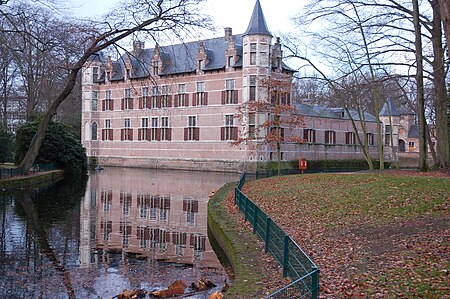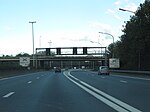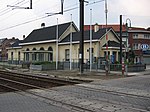Ekeren

Ekeren (Dutch pronunciation: ['eːkərə(n)] (listen)) is a northern district of the municipality of Antwerp in the Flemish Region of Belgium. The suburb celebrated its 850th birthday in 2005; the name of the town was first mentioned in 1155, as "Hecerna". The name possibly originates from Vikings who settled there in the ninth century after using the oak trees.Ekeren used to be the home town of the Germinal Ekeren football club until Germinal merged with K. Beerschot V.A.C. into K.F.C. Germinal Beerschot (in 1999). The new club is based in the Olympisch Stadion in Antwerp. Ekeren is home to the Jozef Pauly municipal academy for music and diction, which has around 2000 pupils as of 2004 (also counting branches in some other districts of the city of Antwerp, and one in the nearby municipality of Kapellen). The academy hosts many musical ensembles; the Jozef Pauly flute ensemble has made concert tours to Australia and the United States. Municipal music academies in Belgium are distinct from the public educational system; attending these academies is entirely optional, and merely a hobby for most of the students. The 1 square kilometre large domain of the Oude Landen is a unique and extremely diverse natural sanctuary situated near the border with the Antwerp city district. Since it was a military area until 1972 (but not often used as such) where trespassing was strictly forbidden, nature was allowed to have its way for decades; the area now contains a rich mixture of plants and animals in eight more or less separate miniature ecosystems. The border between Ekeren and the Antwerp district was changed per 1 January 2019, which transferred several Antwerp neighbourhoods with about 5,000 inhabitants to Ekeren. Ekeren is also the hometown of well known Belgian/American musician Christian Olde Wolbers of legendary American music group Fear Factory
Excerpt from the Wikipedia article Ekeren (License: CC BY-SA 3.0, Authors, Images).Ekeren
Kloosterstraat, Antwerp
Geographical coordinates (GPS) Address Nearby Places Show on map
Geographical coordinates (GPS)
| Latitude | Longitude |
|---|---|
| N 51.283333333333 ° | E 4.4166666666667 ° |
Address
Kloosterstraat 123
2180 Antwerp
Antwerp, Belgium
Open on Google Maps









